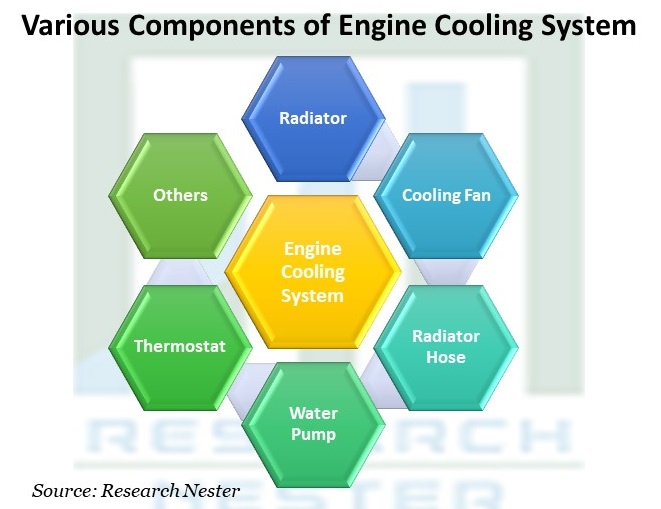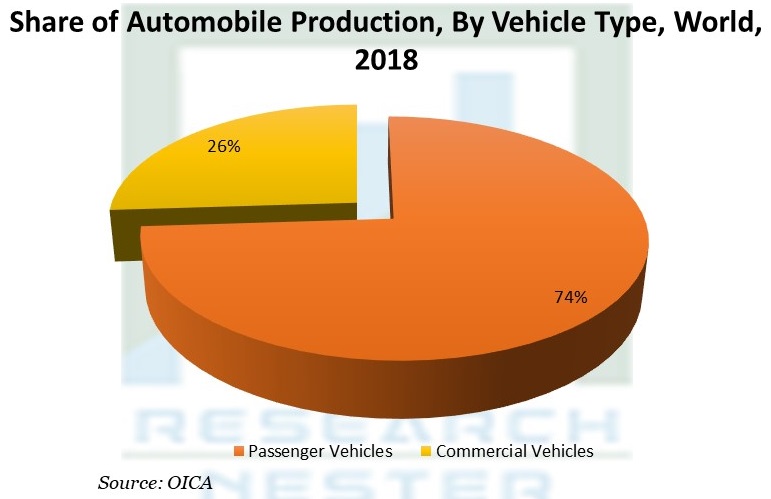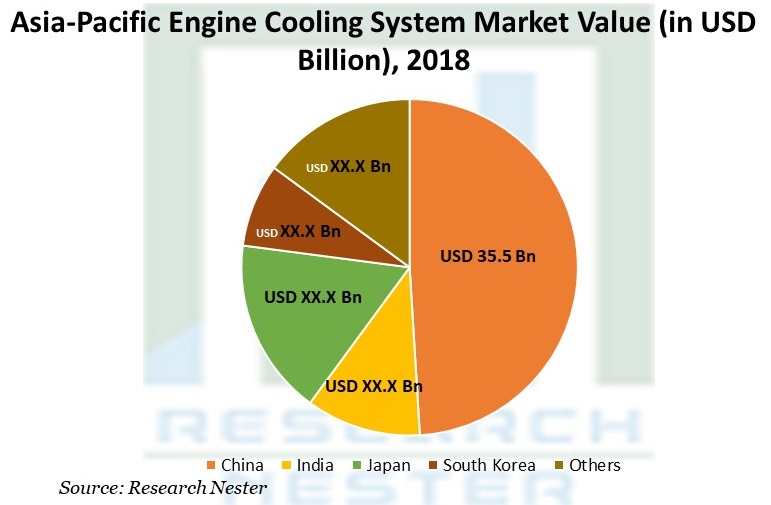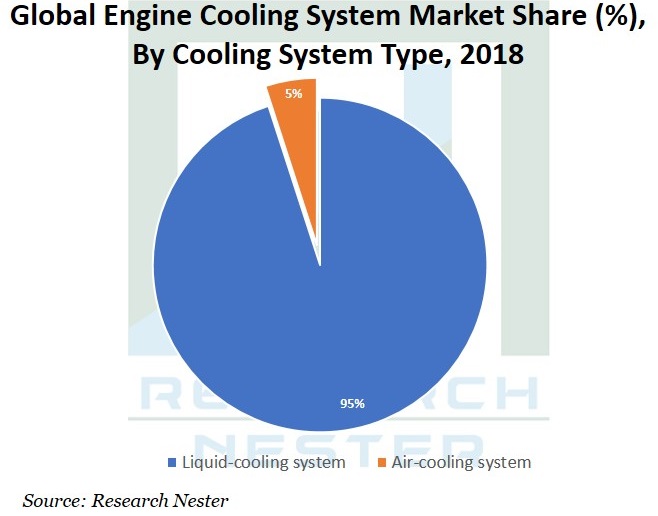Introduction to Engine Cooling System
An internal combustion engine generates a lot of heat while functioning. It uses liquid or air-cooling system to remove the extra heat and prevent the engine from overheating. The ability of the engine cooling system to control the engine temperature makes automotive engine cooling system a critical part of a vehicle. Various components together form the engine cooling system, such as, radiator, cooling fan, radiator hose, water pump, thermostat, expansion tank and others.

Market Overview
The growth of the global automotive engine cooling system market is thriving on the back of increasing automotive production, which impacts the OEM sales of the components, coupled with the rise in global vehicle population on the road, which drives the aftermarket sales of the engine cooling system components. According to The Organisation Internationale des Constructeurs d’Automobiles (OICA), total production of automobiles during the year 2018 was around 95.6 million units. Additionally, production of passenger vehicles for the same year constituted to around 74% share of the total automotive production. CLICK TO DOWNLOAD SAMPLE REPORT

Global automotive engine cooling system market reached USD 147.8 billion in 2017 and is expected to garner USD 219.6 billion by the end of 2027 by registering a CAGR of 4.5% across the globe over the forecast period 2018-2027.
Regional Growth Highlights during 2018 – 2027
The global automotive engine cooling system market is segmented by regions into North America, Latin America, Europe, Asia-Pacific and Middle East and Africa, out of which, Asia Pacific held the top rank in the global engine cooling system market during 2018, with nations such as China and Japan, and it is anticipated to hold its dominance by expanding at a compound annual growth rate (CAGR) of 5.0% over the forecast period. Global enterprises are increasing FDI in the automotive industry so as to harness the advantage of the low cost of production in nations such as India and China among others, which is contributing significantly towards the growth of the engine cooling system market in the region.
Further, Latin America is anticipated to record significant growth in market share with nations such as Mexico and Brazil, and it is anticipated to grow with a CAGR of 3.6% over the forecast period.

The study further incorporates Y-O-Y Growth, demand & supply and forecast future opportunity in North America (United States, Canada), Latin America (Brazil, Mexico, Argentina, Rest of LATAM), Europe (U.K., Germany, France, Italy, Spain, Hungary, BENELUX [Belgium, Netherlands, Luxembourg], NORDIC [Norway, Denmark, Sweden, Finland], Poland, Russia, Rest of Europe), Asia-Pacific (China, India, Japan, South Korea, Malaysia, Indonesia, Taiwan, Hong Kong, Australia, New Zealand, Rest of Asia-Pacific), Middle East and Africa (Israel, GCC [Saudi Arabia, UAE, Bahrain, Kuwait, Qatar, Oman], North Africa, South Africa, Rest of Middle East and Africa).
Market Segmentation Synopsis
By Cooling System Type
The global engine cooling segment market has been segmented on the basis of cooling system into liquid-cooling and air-cooling system. Liquid-cooling system hold the major share of around 5% and is anticipated to grow with a CAGR of 4.6% over the forecast period owing to their greater application in both passenger and commercial vehicles. Additionally, liquid-cooling system segment is also anticipated to cross USD 210.0 billion by the end of 2027. Liquid engine cooling system happen to be superior in efficiency and also proves to provide greater advantages when compared to air engine cooling system. Moreover, liquid engine cooling system offers better heat transfer properties as compared to air engine cooling system, and unlike air cooling system, liquid cooling system is also independent of outside air temperature and atmosphere, making it a more preferable and acceptable choice among OEMs.

By Vehicle Type
The global automotive engine cooling system market is also segmented on the basis of vehicle type into passenger, light commercial vehicle or LCV and heavy commercial vehicle or HCV. It is observed that there is a high demand for engine cooling systems driven by passenger vehicles segment owing to higher sales of the segment and larger on-road population of the segment, which is also responsible for manifesting growth of the aftermarket sales of engine cooling systems. According to OICA, in the year 2018, the number of passenger vehicles manufactured globally was almost three times that of the commercial vehicles.
The passenger vehicles segment captured around 64% of the total market share in the global automotive engine cooling system market in 2018 and is expected to reach a market valuation of USD 142.9 billion by 2027. Rising per capita income of middle income groups is anticipated to surge the demand for passenger vehicles segment during the forecast period, thereby postulating the growth in complimentary industries, such as the engine cooling system. In addition, LCV segment is anticipated to record a CAGR of 4.1% over the forecast period.
The study further incorporates Y-O-Y growth, demand & supply and forecast future opportunity in North America (United States, Canada), Latin America (Brazil, Mexico, Argentina, Rest of LATAM), Europe (U.K., Germany, France, Italy, Spain, Hungary, BENELUX [Belgium, Netherlands, Luxembourg], NORDIC [Norway, Denmark, Sweden, Finland], Poland, Russia, Rest of Europe), Asia-Pacific (China, India, Japan, South Kora, Malaysia, Indonesia, Taiwan, Hong Kong, Australia, New Zealand, Rest of Asia-Pacific), Middle East and Africa (Israel, GCC [Saudi Arabia, UAE, Bahrain, Kuwair, Qatar, Oman], North Africa, South Africa, Rest of Middle East and Africa).
Market Drivers & Challenges
Growth Indicators
Increasing sales of vehicles around the globe, coupled with the rising population of vehicles on-road, and the need for repair and maintenance of engine parts, all of these factors are believed to aid the global engine system market. Rising demand for repair and maintenance of engine cooling parts of existing old vehicles on-road, is primarily adding up the aftermarket sales of global engine cooling system market. Moreover, continuous advancements in development of cooling systems for engine, and the need for high efficient engines, added with the growing need for high power engines amongst consumers, all of these factors are also anticipated to promote growth of the global engine cooling system market during the forecast period.
Barriers
Rise in the total fleet of electric car, and the initiatives promoted by government of various economies to raise the production of electric vehicles, coupled with surge in the production of electric vehicles, all of these factors lowers the requirement of engine cooling components, which is anticipated to limit the growth of the global engine cooling system market around the globe. According to International Energy Agency, global electric car fleet exceeded 5.1 million in the year 2018, which was up by 2 million from 2017.
Competitive Landscape
Some of the affluent industry leaders in the global engine cooling system market are Schaeffler AG, Valeo, MAHLE GmbH, DENSO CORPORATION, and Delphi Auto Parts.
Besides this, automobile manufacturing companies are also making various efforts to expand their business of engine cooling system to meet increased demands. In various nations across the globe, micro, small and medium enterprises are concentrated to produce the engine cooling system, especially to meet the demand for customization of vehicles, and are fulfilling the demand of the automotive industries in their domestic market, and are also exporting across the globe.

